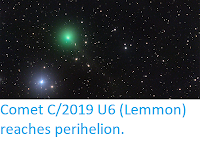Asteroid (441987) 2010 NY65 passed by the Earth at a distance of about 3 758 000
km (9.79 times the average distance between the Earth and the Moon, or 2.51% of the distance between the Earth and the Sun), slightly before 6.45 am
GMT on Wednesday 24 June 2020. There was no danger of
the asteroid hitting us, though were it to do so it would have
presented a considerable threat. (441987) 2010 NY65 has an estimated
equivalent
diameter of 99-310 m (i.e. it is estimated that a spherical object with
the same volume would be 99-310 m in diameter), and an object of this
size would be predicted to be capable of passing
through the Earth's
atmosphere relatively intact, impacting the ground directly with an
explosion that would be 200-7500 times as powerful as the
Hiroshima
bomb. Such an impact would result in an impact crater roughly 1-4.8 km
in
diameter
and devastation on a global scale, as well as climatic effects that
would last years or even decades.
Timelapse made from 411 images of (441987) 2010 NY65 made on 1 July 2016. Asteroid Tracker/Las Cumbres Observatory Network.
(441987) 2010 NY65 was discovered on 14 July 2014 by the Wide-field Infrared Survey Explorer
satellite. The designation 2010 NY65 implies that the asteroid was the 1584th object (object Y65 -
in numbering asteroids the letters A-Z, excluding I, are assigned
numbers from 1 to 24, with a number added to the end each time the
alphabet is ended, so that A = 1, A1 = 25, A2 = 49, etc., which means that Y65 = (24 x 65) + 24 = 1584) discovered in the first half of Ju;y 2010 (period 2010 N), while
the designation 441987 implies that it was 441 987th asteroid ever
discovered (asteroids are not given this longer designation immediately
to avoid naming double or false sightings).
(441987) 2010 NY65 has a 366 day (1 year) orbital period, with an elliptical
orbit tilted at
an angle of 11.6° to the plain of the Solar System which takes in to
0.63 AU from the Sun (63% of the distance at which the Earth orbits the
Sun, and slightly inside the orbit of the planet Venus) and out to 1.37 AU (137% of the distance at which the Earth orbits
the Sun).
This means that close
encounters between the asteroid and Earth are fairly common, with the
last thought to have happened in June 2019 and the next predicted
in June 2021. It is therefore classed as
an Apollo Group Asteroid (an asteroid that is on average further from the Sun
than the Earth, but which does get closer). As
an asteroid probably larger than 150 m in diameter that occasionally
comes within 0.05 AU of the Earth,(441987) 2010 NY65 is also classified
as a Potentially Hazardous Asteroid. (441987) 2010 NY65 also
has occasional close encounters with the planets Venus, which it last
came close to in May this year (2020) and is next predicted to
pass in May 2053.






